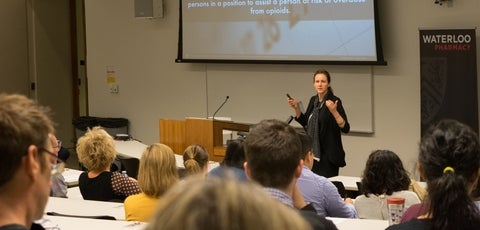On November 10, the School of Pharmacy opened its doors to Waterloo Region welcoming over 100 audience members to the School’s annual Public Lecture.

Entitled The Opioid Crisis: A local perspective on an international issue, the lecture drew a diverse crowd. Member of local non-profits, pharmacists, the police, social service workers and more heard Dr. Michael Beazely, Chris Harold from Region of Waterloo Public Health, and Dr. Kelly Grindrod discuss opioid use and misuse in the Region.
How did the opioid crisis develop?

“The term ‘opioid’ can be used to describe any chemical with morphine-like effects,” Dr. Mike Beazely indicated. Pharmaceutical opioids include morphine, codeine, oxycodone and fentanyl, and they are often prescribed to relieve pain.
Dr. Beazely broke down the development of the opioid crisis, explaining that while opioids were considered highly addictive pre-1980, the prescription of opioids began to rise in the 1990s and throughout the 2000s. A recent report by the Institute of Clinical Evaluative Sciences at St Michael’s Hospital and the Ontario Drug Policy Research Network indicated that in 2015, nearly 24,000 people in Waterloo Region were using opioids.
This drastic rise in opioid use, combined with changes in dosage form of the drug, has resulted in increased risk for addiction among users and increased ability to access high quantities of the medications. Certain opioids, such as fentanyl, are especially potent.
Fentanyl is 80 times more potent than morphine. When it’s cut into other illicit drugs, the risk of overdosing increases drastically.
The response to opioid use in Waterloo Region
Chris Harold, Information Manager and representative from Region of Waterloo Public Health, explained that it’s difficult to track how many people in Waterloo Region have overdosed on fentanyl or other opioids. Part of that challenge likely stems from the stigma attached to addiction and to drug use.

Thus, the Region has taken a multi-pronged approach to combatting the opioid crisis. Public Health runs, supports, or participates in initiatives like harm reduction programs, the development of a monitoring system, and needle syringe programs, to name just a few.
Pharmacists in particular are in a unique position to help. In an unprecedented move, the Canadian government has approved naloxone, an antidote for opioid overdoses, to be available as a Schedule II drug in pharmacies.
“Schedule II means that the drug is available behind the counter without a prescription. You have to talk to a pharmacist to get it,” Dr. Kelly Grindrod told the audience.
The drug is available to anyone who is currently using opioids, a past opioid user, or a family member, friend or other person in a position to assist a person at risk of overdose from opioids. Anyone can request a naloxone kit.

In Ontario, not only is naloxone available without a prescription, but it is also free. While Dr. Grindrod explained that only approximately 8 pharmacies in the region are regularly carrying naloxone, she was adamant that pharmacists can play a vital role in making this life-saving medication easily available to the public.
“Ask your local pharmacy if they carry it,” she advised the audience during the question and answer period. “If they don’t have it, tell them you’ll be back in a week.”
Dr. Grindrod and her team created shared this video with the audience to demonstrate naloxone administration: